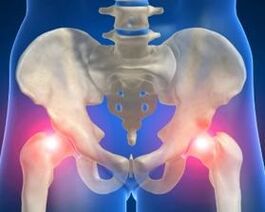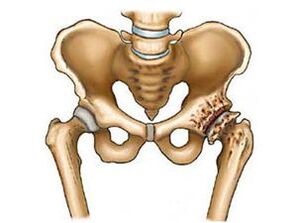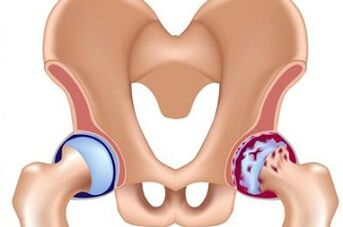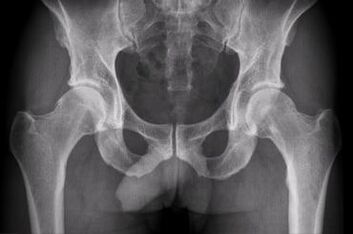
Hip joint arthritis (coxartrosis) is a chronic disease, which progresses gradually, in the absence of timely and proper treatment, can result in a complete loss of movement in it.The end suggests that not an inflammatory, but a degenerative process prevails.
The symptoms of this disease vary depending on the stage.At first, this is a barely noticeable discomfort that occurs when you walk and exercise.Perhaps the manifestation in the form of poor pain in the thigh, which passes through the rest.In this case, the pain can be felt not only in the thigh, but also in the groin or knee.
As a rule, coxarthrosis is a process that is flowing for many years, characterized by a gradual change in cartilage, followed by bone deformity and loss of common functionality.Mostly affects people after 40 years, but very young patients are also found.
Causes
Why does hip union arthritis occur, and what is it?The causes of coxarthrosis may be different, but the picture of the disease is always the same.It all starts with changes in the articular cartilage, which is thinner and loses the cargo depreciation property.The body compensates the stratification of the cartilage tissue with the formation of bone growth along the edge of the articular surfaces, which leads to the deformation of the joints and bones of different degrees.
The main causes of this common disease:
- hurt.This cause may not be a major lesion, but in many cases, chronic microtraums affect the development of the disease that contribute to cracking and thinning of the cartilage.They also affect the anxiety of the joint capsule, leading to the accumulation of many damage.Often recurrent microtraumas are the precursor to the appearance of such a disease.
- Overloadleading to systematic microtrauma as well as common injuries.Most often, this is found in people engaged in heavy physical work or professional athletes.In this case, treatment without changing the lifestyle or load restrictions is also ineffective and is often associated with relapses.
- Hereditary predisposition.This includes abnormalities in the development of the femoral head itself, underdevelopment of common elements, etc.In this case, the so -called hip fusion of the hip joint occurs.
- DISEASES.For example, arthritis, in the absence of proper treatment, can degenerate into arthritis over time.This is due to the fact that during arthritis the properties of cardiaginous tissue change, circulatory disturbance occurs.Gradually, this leads to the development of a degenerative process.
- Excessive body weight.Excessive body weight, even when walking, has a load on joints that exceed their physiological boundaries of force.
Depending on the cause of the development of the disease and its pathogenesis, 2 main types of hip joint arthrosis are distinguished.

- Primary coxartrosis.In this case, the disease develops very slowly and begins with the damaged blood supply to the tissue.The reasons for the development of this type of arthritis are rooted in violation of metabolism, which is more characteristic for people over 50 years of age.The primary arthrosis of the hip joint is more commonly diagnosed.
- Secondary coxetrosis.In this case, the disease develops against the backdrop of the systemic inflammatory lesion of many joints in the body.Inflammation can be an infectious and autoimmune nature.
In the initial phase of patients' coxartrosis, only mild pain or a feeling of disturbance in the joint area is disturbed.Often such signs are ignored, as a result of which the disease progresses.
Symptoms of hip joint arthrosis
Coxarthrosis of the hip joint, whose symptoms cannot be ignored, can lead to serious consequences.There are some basic signs of the disease that depend on the stage of the disease:
- Pain in the joints is the most obvious symptom by which any TBS disease can be assumed.The intensity and nature of the sensations usually depend on the phase.
- Limiting limb mobility is also a symptom of coxarthrosis.For the early stage, the sensation of the "limitation" of the joint, which passes after a load, is characteristic.
- Weakening of the hip muscle can already be observed in the second stage of the disease, reaching the third to complete atrophy.
- Changing the length of the foot due to pelvic deformity is characteristic of "neglected" osteoarthritis.
- Lame or walking change is a very possible sign of bone deformity.
- A special crisis in the union is always from a sign of arthritis.They are usually taken into account if there are other symptoms.
The main characteristic of coxarthrosis is the pain, the nature of which, its duration, localization and intensity depend on the stage of the disease.
Arthritis of the 1st degree hip hip
This stage of the disease is characterized by pain in the joints and thighs, sometimes in the knee that occur after physical activity and descend after rest.The mobility of the union is not limited and there is no violation of walking.
Coxartrosis of the scale of 1 is the initial stage of the disease, starting with the treatment of which, you can still stop the process of destroying and deforming the node and maintain its functions completely.But, unfortunately, many do not consider it necessary to see a doctor because of poor pain in the joints, and the disease, meanwhile, progresses.
Hip 2 -degree arthrosis

It manifests more clearly - the intensity of the pain increases, occurs not only after load but also at rest, there is a restriction of motor functions.In particular, coxarthrosis is characterized by the difficulty in performing the pronunciation (inner thigh rotation) and abduction, contracting is formed.
On an X -Ray examination, we see a narrowing of the articular space and appearance on the bone growth surfaces.The reversible cavity and the femoral head are deformed.The thigh muscles on the side of the lesion have begun to atrophy, and the pain syndrome spreads below, capturing both the knee and the inguinal region (it is important to understand that this will not be associated with dystrophic changes in the knee joint).
Hip 3 degree arthrosis
Signs of the disease are pronounced and are constant.Pain syndrome overcomes at night.When walking, the patient uses support.The lower leg muscles and thighs are gradually atrophy, and the sick person of the sick person becomes much shorter.
Often, in the 3rd degree, the joint gap disappears completely, and the joints grow together in a single bone structure, this demonstrates a picture.As a result, complete immobility of the union occurs.
Radiographs determine widespread bone growth from the roof of the femur and the head of the femur, a sharp narrowing of the joint gap.The neck of the femur has expanded and shortened significantly.
Troubleshooting
Before discovering how to treat the arthrosis of the hip joint, it is necessary to make a diagnosis correctly.In case of suspicion of coxarthrosis, a person will aim to perform a biochemical blood test - in the presence of a disease, patients have a slight increase in ESR, globulins, immunoglobulins and serumucoids.
The next stage in the detection of arthrosis is an X -Ray photo.Will identify:
- Delivery of the cartilage,
- bone growths on the cartilage border,
- the narrowing of the distance between the joints,
- Compound bone tissue under the cartilage.
Unfortunately, an X -Rray photo does not allow the joint capsule and the cartilage itself, if you need to get information about these soft tissues, then the patient will be directed to the tomography.
Hip joint arthrosis treatment
With diagnosed arthrosis of the hip joint, the treatment will depend directly on the stage at which the disease is located.The general treatment scheme provides for the achievement of the following goals:
- eliminate pain and discomfort in the sore joint area;
- to set the food of intra -articular cartilage and begin the process of its restoration;
- eliminate intraarticular fluid deficiency;
- activate microcirculation in joint tissue;
- eliminate the increased load on the hip joint;
- strengthen the muscles that surround, protect and maintain joints;
- Prevent deformation and increase movement in the thigh joint.
All of this can only be achieved with the help of an integrated approach, which should include not only medication therapy but also a change in lifestyle in order to get rid of the risk factors of coxarthrosis.

- In the third stage of the disease, treatment involves the operation, during which the fusion is replaced by an endoprostese, while part of the prosthesis is imprisoned in the femur, and parts of the pelvis.The operation is quite complicated, long in time and requires a long period of rehabilitation.
- With the degree I and II of the hip joint arthrosis, treatment is performed without surgical intervention.Used: non -inflammatory drugs non -inflammatory, muscle relaxants, chondroprotectors, vasodilating medicines, hormone steroids, local medicines -Ointments, lotions, compresses.
All these medicines are prescribed exclusively by the attending physician.Some of them are effective in the form of injections directly in the affected articular region.Such injections can only be made by qualified medical personnel.Therefore, self -medication is not strictly recommended.
Methods No -DRUG
In addition to using medicines, doctors recommend non -Drug methods to combat the disease.These include the following methods of treating this disease:
- physiotherapy;
- massage;
- joint breeding;
- diet
Physiotherapy used for arthritis includes the following types of treatment:
- magnetotherapy;
- UHF and ultrasonic therapy;
- aeroion and electrotherapy;
- inductootermia;
- phototherapy;
- Using laser technology.
All of these methods can only be used to improve blood supply to the joints and facilitate spasms.
Drug therapy
Combined treatment of hip arthrosis predicts the appointment of the following medication groups:

- Nonsteroidal anti -inflammatory drugs, everyone eliminates pain, relieve inflammatory processes, but do not restore cartilage tissue.
- Chondroprotectors.Preparations for cartilage tissue nutrition.Accelerating its restoration.Important in the 1.2 stage of treatment of arthrosis.With 3 degrees of illness, the cartilage is already destroyed, these medicines will be useless.You have to take drugs for a long time, take some courses.
- MusorexantEliminate muscle cramps in the field of sore joints, contribute to improving the blood supply of tissues.
- Ointments and creams.Therapeutic ointments are to ease the condition of a sick person but do not contribute to a complete recovery.Heating ointments are appropriate.They irritate skin receptors, and because of this they reduce pain syndrome.Oil warming also works to restore increased blood flow to tissues and muscles located around the diseased joint.
- Steroid injections into the joint cavity, injections of these drugs are prescribed to relieve the worsening of the disease and eliminate severe pain.
- Vasodilat, expand the vessels inside the joint cavity and near it, thereby improving the distribution of nutrients needed to restore the tissue.
It is not necessary to rely on popular treatment remedies.But some healers recommend the lemon, garlic or celery root solution for the treatment of joints and bones.
Massage in the treatment of coxarthrosis
With the deformation of the arthrosis of the hip joint, massage treatment gives good results.Massage for coxarthrosis is a very effective and useful method.It is desirable for the massage to be carried out by a good specialist and as often as possible.
Its effect is aimed at improving blood circulation, strengthening muscle, removing a painful spasm, swelling and muscle tension, and an increase in diastasis between joint articulations.
In the absence of a professional massage therapist, the massage can be done on its own.Massage with arthritis can be carried out by hand and using various massage equipment and even water planes (hydrokinesotherapy).
Gymnastics
The treatment of hip joint arthrosis with physical education lies in the achievement of two tasks: increase the motility of the feet and prevent muscle atrophy.All standard LFK complexes for coxartrosis also have a general nature strengthening and a positive effect throughout the organism.
The gymnastic exercise complex is described by a specialist.The first medical physical education should be developed under the supervision of a physician.It will show how to properly perform any movement, and also control the proper load on the hip joints.
Diet
Key Recommendations:
- Give the porridge preference in the water.
- Use a sufficient amount of animal protein: fish (other than salt), poultry, beef.
- Use at least 5 vegetable services a day (one part - 100 grams, can be used as a side dish).
- Mandatory milk products: cottage cheese, yogurt, fermented.
- Exclude alcohol, coffee, strong black tea.
- Exclude sweet flour ,.
- Eat a little, but often.
The diet will reduce the load on the hip joints and provide them with everything that is needed to restore the tissue.


















